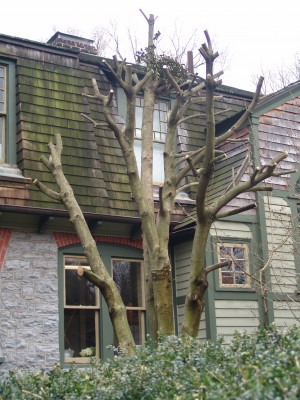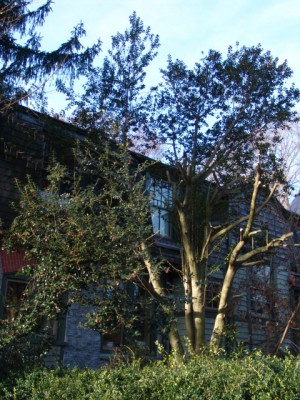Hat Racking Hollies
At the Scott Arboretum we have many mature hollies. Over time these majestic plants develop a broadly pyramidal habit which often spreads out at the base and can encroach on pathways, buildings, etc. Fortunately, most species of Ilex respond well to a severe type of pruning called ‘hat racking’ which rejuvenates large and overgrown hollies. We have successfully applied this type of pruning to Ilex aquifolium, Ilex opaca, and most recently to a hybrid holly, Ilex ‘Doctor Kassab’.

This practice is best completed in March. I like to step back from the plant and draw an imaginary outline of where I want to prune the tree. On a pyramidal American holly, Ilex opaca I will reduce many of the branches so the remaining habit reflects a very tight pyramid.
On March 14, we pruned our Kassab holly in front of the Arboretum offices. The overall habit of this plant is somewhat rounded so the approach was to reduce all branches by 2/3rds thus leaving a much reduced, but still rounded tree.
The term ‘hat racking’ was coined because virtually all the branches with leaves are removed leaving a skeletal network of branches which looks like a hat rack. In spring these naked branches will be covered with leaves which will emerge from latent buds on all the stems. The first growing season the tree will still be fairly open, but by the end of the next year’s growing season the tree will show very little sign of having been severely pruned.






Laura
Posted at 20:35h, 25 MayI have what I believe is a type of holly shrub. It’s only about 2 feet tall but it spreads out like a canopy around a lamp post. It is at least 20 years old. It used to be pruned regularly, but has been, inadvertently, ignored for the last few years and has become rangy with about a two foot wide bare spot where it appears it has died. The outermost leaves (very small) look great, but it’s thick woody stems are long and bare. I think it needs a good pruning, but I’m afraid to prune it back as far as it appears to need to fill in again. Any ideas? I can post a picture, if any one can tell me how and help me identify the shrub and it’s needs. Thanks, Laura
Andrew Bunting
Posted at 11:01h, 26 MayLaura,
If you can send me an email image to abuntin1@swarthmore.edu I can probably better address your pruning question.
Andrew Bunting, Curator
David Martin
Posted at 23:27h, 31 DecemberI linked this blog entry to my reply t a query about getting a holly away from the sidewalk of a newly-purchased house in Florida. I added a disclaimer to the effect that doing the same thing to crape myrtles amounts to plant abuse.
I suppose that a regional guide to landscape plants’ toleration of severe pruning (or outright coppicing/cutting back to the ground) could be of some use.
I’d been introduced to hatracking as a legitimate, if drastic, technique by (I think) a paperback pruning handbook from the Brooklyn Botanic Garden, which is currently in hiding.
Frank
Posted at 10:14h, 25 JanuaryI live nearby in Media and have two American (I believe) Hollies on opposite sides of the steps leading up to our front door. They are about 30 years and they are intruding on the entrance to our house. I have had some local landscapers comment that they should be cut down and removed since they are the wrong type of tree for the locations. Can you recommend some local arborists that could hat rack our hollies?
Andrew Bunting
Posted at 10:16h, 26 JanuaryFrank,
I would try to find an arborist who can do this type of pruning. You might even want to show them this blog. For this type of work on campus we would use Bartlett Tree Care. Our local rep is John Studdy.
Andrew Bunting, Curator
Becky Robert
Posted at 10:28h, 26 JanuaryBartlett Tree Expert Co. also offers a 10% discount on all services to Scott Arboretum members. Follow this link for details http://www.scottarboretum.org/membership/discountprogram.html
Wayne Tyson
Posted at 19:01h, 11 DecemberThis “technique” is popular with “professional” tree-pruners who may want to have to come back year-after-year and extract more and more sap from the customers bank account, as it causes flushes of growth (many, many “suckers” and green in the “professionals’ pockets) that require immediate follow-up pruning if a tangled mess of intercrossing branchlets/branches is to be avoided. “Heading” should almost always be avoided, but when branches must be shortened they should be cut back to a lateral, which itself should be tied into the position desired to restore the tree’s form. Even then, heading of heavy branches will result in a tangle of branchlets, which should all be removed except the one selected to take over at the cut. Usually it is far better to remove an entire branch than to “head back.” “Hatracking” and entire tree is almost always bad practice for which there is no reasonable excuse. “It ain’t rocket science,” but there are well-established principles of pruning that are widely available in easy-to-understand books.
“Hatracking” may be “cheaper” (costlier in the long-run) expedient, but it is hardly acceptable, much less professional practice.
Responsible tree care should not be delayed until chain saws are required. A truly good professional pruner, if retained every year, should be able to properly train tree growth with hand pruners and an occasional hand saw for times when mistakes have been made in the previous year or two. That is cheaper than butchering a tree ever five or ten years or more. A properly trained young tree should grow into a mature one that requires little, if any, further methods. Neglected for years, however, a badly misshapen tree will sometimes require drastic, dangerous, and expensive cutting or removal. Branch and tree falls that all to frequently kill, maim, and damage or destroy property, people, and other animals are often blamed on “an act of God.” If a human planted or mismanaged a tree, no matter how well-intentioned, the resulting disaster can hardly be blamed on The Creator.
Andrew Bunting
Posted at 09:07h, 12 DecemberThis article is about “hatracking” hollies specifically. We would never suggest this type of pruning on any other type of plant, but for hollies, in particular, Ilex opaca, Ilex x koehneana, and other tree-form hollies with a central leader this is an effective way to rejuvenate and large and overgrown trees. We have several large and overgrown American hollies at the Scott Arboretum that are encroaching on buildings, etc. We use this practice to reduce the overall size of the plant. The result is that within two years we have a beautifully shaped holly that is often 25% its orginal size. There is no follow up pruning necessary with hollies, because we desire a thick twiggy and dense look. For all other trees at the Arboretum we follow the latest and approved arboriculture practices. This practice would be very counter productive on any other type of tree species.
Andrew Bunting, Curator
PJ
Posted at 15:26h, 07 AprilWould this work for Japanese Hollies as well?
Andrew Bunting
Posted at 10:53h, 08 AprilYes, this can be applied to Japanese hollies.
Andrew Bunting, Curator
www.treetrimmingtemecula.com
Posted at 21:09h, 28 MayThis would work on my garden too. I will definitely try this out.
Becky Robert
Posted at 09:21h, 30 JulyI hope your project worked, John.
Sincerely,
Becky Robert
Scott Arboretum
john
Posted at 17:18h, 08 JuneGorgeous landscape! I got so many ideas here,
Becky Robert
Posted at 08:45h, 09 JuneDear John,
Glad you found inspiration.
Happy Gardening!
Becky Robert
PR and Volunteer Programs Coordinator